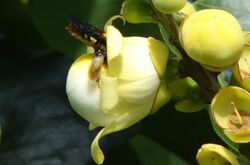| Display title | Biology:Epicharis (bee) |
| Default sort key | Epicharis (Bee) |
| Page length (in bytes) | 2,184 |
| Namespace ID | 3026 |
| Namespace | Biology |
| Page ID | 654017 |
| Page content language | en - English |
| Page content model | wikitext |
| Indexing by robots | Allowed |
| Number of redirects to this page | 0 |
| Counted as a content page | Yes |
| Page image |  |
| HandWiki item ID | None |
| Edit | Allow all users (infinite) |
| Move | Allow all users (infinite) |
| Page creator | imported>John Stpola |
| Date of page creation | 09:47, 13 June 2021 |
| Latest editor | imported>John Stpola |
| Date of latest edit | 09:47, 13 June 2021 |
| Total number of edits | 1 |
| Recent number of edits (within past 90 days) | 0 |
| Recent number of distinct authors | 0 |
Description | Content |
Article description: (description)
This attribute controls the content of the description and og:description elements. | The genus Epicharis contains fewer than 40 species of large apid bees occurring in the Neotropics (from Mexico to Brazil ), most of which possess adaptations for carrying floral oils rather than (or in addition to) pollen or nectar. The floral oils are typically gathered from plants of the family Malpighiaceae... |

